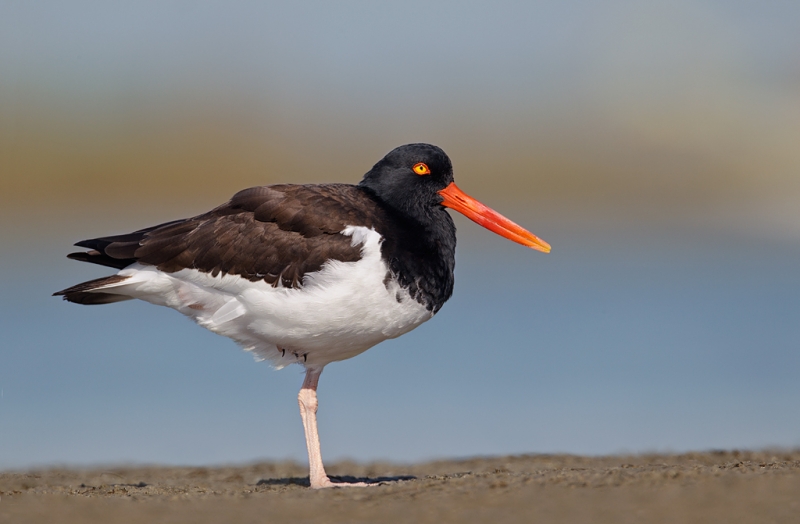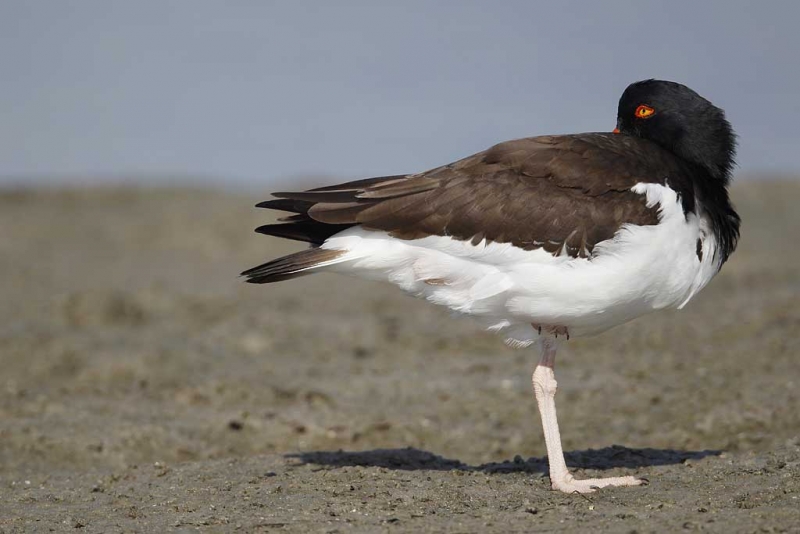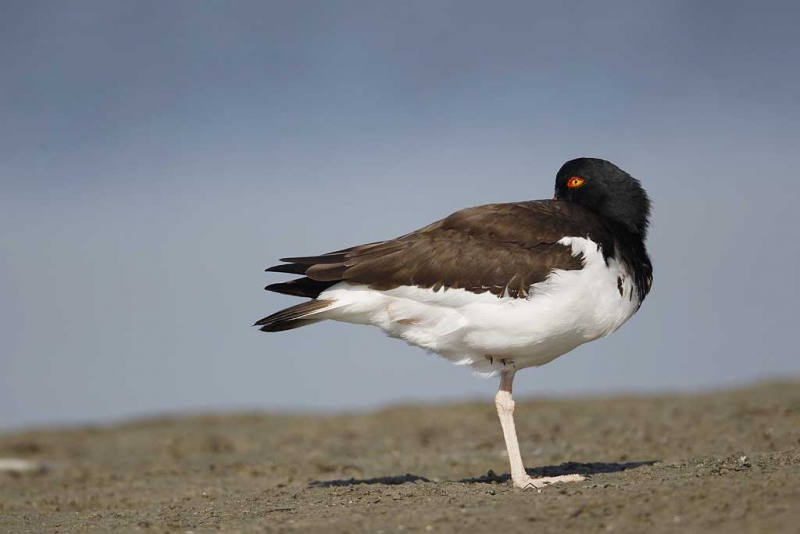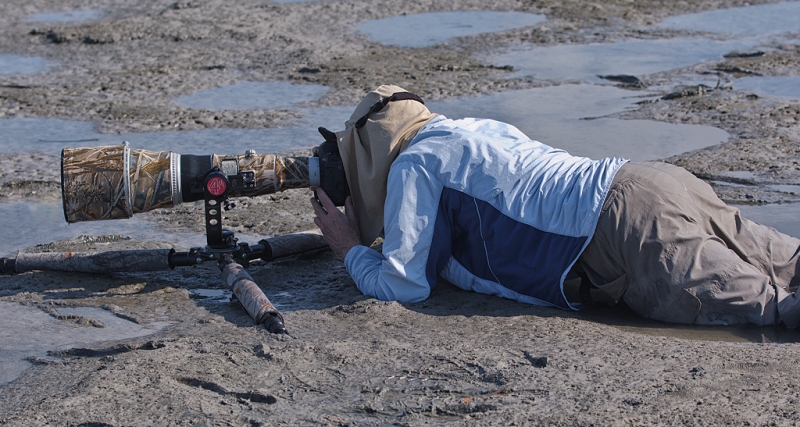|
American Oystercatcher, adult, Little Estero Lagoon, Fort Myers Beach, FL. Created with the tripod-mounted Canon 800mm f/5.6L IS lens, the 1.4X III TC, and the EOS-1D Mark IV. ISO 200. Evaluative metering +1/3 stop: 1/500 sec. at f/11 in Av Mode. Central Sensor (by necessity) Rear Focus/AI Servo AF and recompose. Click here if you missed the Rear Focus Tutorial. For a greater appreciation of the image, click on the photo. Then click on the enlarged version to close it. |
Was It Worth It?
It was a bit after 10am on a clear day. We had had a great morning on the SW FLA IPT with lots of egrets and Brown Pelicans in flight, lots of tame Wilson’s Plovers, and an Osprey that flew by with a small tree for its nest. We were thinking about heading back to the motel when a family group of 3 American Oystercatchers landed in front of us. I guided everyone on approaching with care so as not to flush these sometimes shy birds.
|
Same bird, same gear… |
I created the image above while standing behind my tripod, knowing that with the shoreline dissecting the bird’s neck and upper back that it would not be a good image. And I half expected that the birds would take flight at any moment. But at least the image served as a good exposure check. And I did realize that I was a bit too close; remember: it is generally best that the bird not take up more than 75% of the longest dimension of the frame.
|
Again, same bird, same gear… |
I took a few steps back, lowered the tripod legs, and got down on one knee, knowing that with the shoreline cutting the bird’s leg just above the ankle that I would not be happy with the image, all the while realizing that if I got down flat on my belly that I would have a lovely, diffused strip of green background right behind the oystercatcher’s head. But, and this was a very big but, to get down flat I would need to go belly down in wet mud on a somewhat chilly morning. I was not looking forward to it, but I knew that it was the way to go…. So I went.
|
Image courtesy of and copyright 2012 Tim Kaufman. |
Yup, that’s me in the wet muck. Not much fun but I like the final image. Note that as I did not have my panning ground pod in my vest–I did not expect many shorebirds–that I simply splayed the legs of the tripod in order to get low fast. Thanks Tim for the image.
The Questions…
There are lots of questions here. Was it worth it? Would you have done it? Of the folks in the group, only Clemens van der Werf got down on his belly but he kept his mid-section out of the water :). I tried that and it worked for a while but I finally succumbed and would up with wet mud-belly.
Support both the Bulletins and the Blog by making all your B & H purchases here.
Remember: you can earn free contest entries with your B & H purchases. Eleven great categories, 34 winning and honored images, and prize pools valued in excess of $20,000. Click here for details.
Comments on Comments
I commented extensively on your comments in the January 6, 2012 post, “My Comments on: For Your Critique/Image #6.” Amazingly, only a single person who commented agreed with me :). Different strokes…
In addition, I did the same on the comments at the January 8, 2012 12 post, “Antarctic Inspiration from Paul Mckenzie.”
Shopper’s Guide
Below is a list of the gear used to create the images talked about in this blog post. Thanks a stack to all who have used the Shopper’s Guide links to purchase their gear as a thank you for all the free information that we bring you on the Blog and in the Bulletins. Before you purchase anything be sure to check out the advice in our Shopper’s Guide.
Canon 800mm f/5.L IS lens. Right now this is my all time favorite super-telephoto lens.
Canon 1.4X III Teleconverter. Designed to work best with the new Series II super-telephoto lenses.
Canon EOS-1D Mark IV professional digital camera body. My two Mark IVs are my workhorse digital camera bodies.
And from the BAA On-line Store:
LensCoats. I have a LensCoat on each of my big lenses to protect them from nicks and thus increase their re-sales value. All my big lens LensCoat stuff is in Hardwood Snow pattern.
LegCoat Tripod Leg Covers. I have four tripods active and each has a Hardwood Snow LegCoat on it to help prevent further damage to my tender shoulders 🙂
Gitzo GT3530LS Tripod. This one will last you a lifetime.
Mongoose M3.6 Tripod Head. Right now this is the best tripod head around for use with lenses that weigh less than 9 pounds. For heavier lenses, check out the Wimberley V2 head.
CR-80 Replacement Foot for Canon 800. When using the 800 on a Mongoose as I do, replacing the lens foot with this accessory lets the lens sit like a dog whether pointed up or down and prevents wind-blown spinning of your lens on breezy days by centering the lens directly over the tripod.
Double Bubble Level. You will find one in my camera’s hot shoe whenever I am not using flash.
The Lens Align Mark II. I use the Lens Align Mark II pretty much religiously to micro-adjust all of my gear an average of once a month and always before a major trip. Enjoy our free comprehensive tutorial here.
Canon EOS-1D Mark IV User’s Guide. Learn to use your Mark IV the way that I use mine. Also available for the 7D and the Mark III here.
BreezeBrowser. I do not see how any digital photographer can exist without this program.


















Of course it was worth it – I would have done the same thing without hesitation! Great background colors.
You and I and Clemens are birds of a different feather :).
I’ll take that as a complement 🙂
Actually, it was intended as a compl i ment…
Indeed it was worth it. Sacrificing present comfort for future benefits is always worth it!
Would not have hesitated for a second. The only thing I might have done differently is hand hold the gear which would have resulted in getting even lower. That technique is of course physically demanding, so the shots should be thought through in advance if possible.
Be careful. Getting lower is not always better. Here, the green diffused strip of color would have dissected the bird’s body….
I am impressed by your efforts as usual Artie. Though not being an artist, I would not have considered all the angles. Still, at a mere 58 I’ve plenty of time to learn, and plenty of youthful energy for jumpimg up and down in the mud! Probably.
Ah, a child.
Sure it was worth it, but it is time for some Gore-Tex clothes!
If I had had on Gore-tex chest waders I likely would have scooped up some water and mud anyway. Sometimes it’s just best to take your punishment :).
Yes I like the final image – was it worth it yes. Was there an alternative – yes would it have been as good – straight answer theoretically no, but practically?? Who knows? What about adding canvas as opposed to a wet tum?
Practically, no way. I know :).
You are driven. I would not do it. True,I am several years older than you, but even at your age (60+) unless it was a shot of a life time. I am pretty sure that it was not the shot of your like time.
But, as another comment said, that is why you are who you are. Great shots.
You are correct sir. Not the shot of a lifetime by far. But a better image…. Many thanks for your kind words.
Artie: Only you can decide whether it was worth it, but no question it’s by far the best of the three images; very nice indeed. Thanks for the teachable moment. A question for you. When I photograph American oystercatchers on Nantucket, they always have noticeable leg bands. Did you just get lucky, or was the banded leg the one the bird had tucked up, or do none of the birds where you were have bands?
Best wishes,
David
Thanks David. You have given the five star answer. When folks ask me is it worth it to buy this camera or that lens, I ask, “How can I possibly know if it is worth it for you?”
There are very few banded birds of this species down here. However,good luck finding an un-banded Snowy Plover in Florida…. It’s just a matter of where the researchers are and the status of local populations. Researchers cause a helluva lot more disturbance of nesting birds than all the nature photographers combined but guess who classes whom as criminals?
The last time I had a photo session was a few days ago. I was lying on my belly in a few inches of snow, the temperatures were sub-zero and I finally gave up after about an hour because I couldn’t feel my fingers anymore. Lying down in a puddle on a warm Florida beach sounds wonderful to me Artie! 🙂
Well, it was a cold(and wet) Florida beach but I do not deal well with cold. That is why I am packing for Japan where we might have -10 to -20 F…. I gotta be nuts. Flying tomorrow.
I shouldn’t think Antarctica was too warm either. I’m sure it will be worth putting up with the cold when you get some pleasing images. Hope you have a great trip Artie.
Antarctica will surely turn out to be toasty when compared to Japan. I hope as always to create a few good images :).
Hi Artie, Yes, definitely worth going the extra puddle! A question about technique – in the prone position like this, do you put your left hand on the lens barrel to get the extra stability? I try to, but find it is extremely awkward! Best wishes, Gerald
Hi Gerald, If need be with a slow shutter speed, I will support the lens from below as I usually do. At 1/500 sec. this is not at all needed.
It’s not that I mind getting down in the mud, but, at my age, it’s doubtful I could get back up!
This is what separates Artie Morris from us mere mortals. Congrats, Artie!
:). Well, I can still get up and down but with a bit more effort than in the past….
Artie,
Once again you’ve inspired me. I’m going to Florida in the next few weeks and will pack a change of clothes for each day trip.
Laurie
That is a very good plan.
Getting down at the eye level of the subject even though it means getting down and dirty or getting in and wet results in an intresting image. Any thing that makes an image intresting is good.
Agree. Strive to get your lens in a spot where nobody else has been and you will create some new and different stuff.
Absolutely, 100% worth it! Crawling in the muck is part of the fun! 🙂
It was worth it for me :). But there is no guarantee that the image will ever sell so worth it only in terms of making me happy. It is actually likely that the image will never sell….
It is always worth it – doing what most people won’t do! If your shot works, great and if it doesn’t great, but at least you gave it all that you could at the time! Only way to live!
G
I am with you on that Gerry. Though I will admit to being quite reluctant :).
You had no choice, you had to do it. If you’re getting dirty, you’re not doing it right. It’s mandatory to get dirty while doing wildlife photography.
Dirty yes, but maybe not wet….
Yup, that’s why you’re the best bird photographer around. Who else would lie in the mud? It’s a much better shot than the other two. Congrats, Artie!
Best or not so smart??? 🙂 It was yucky.